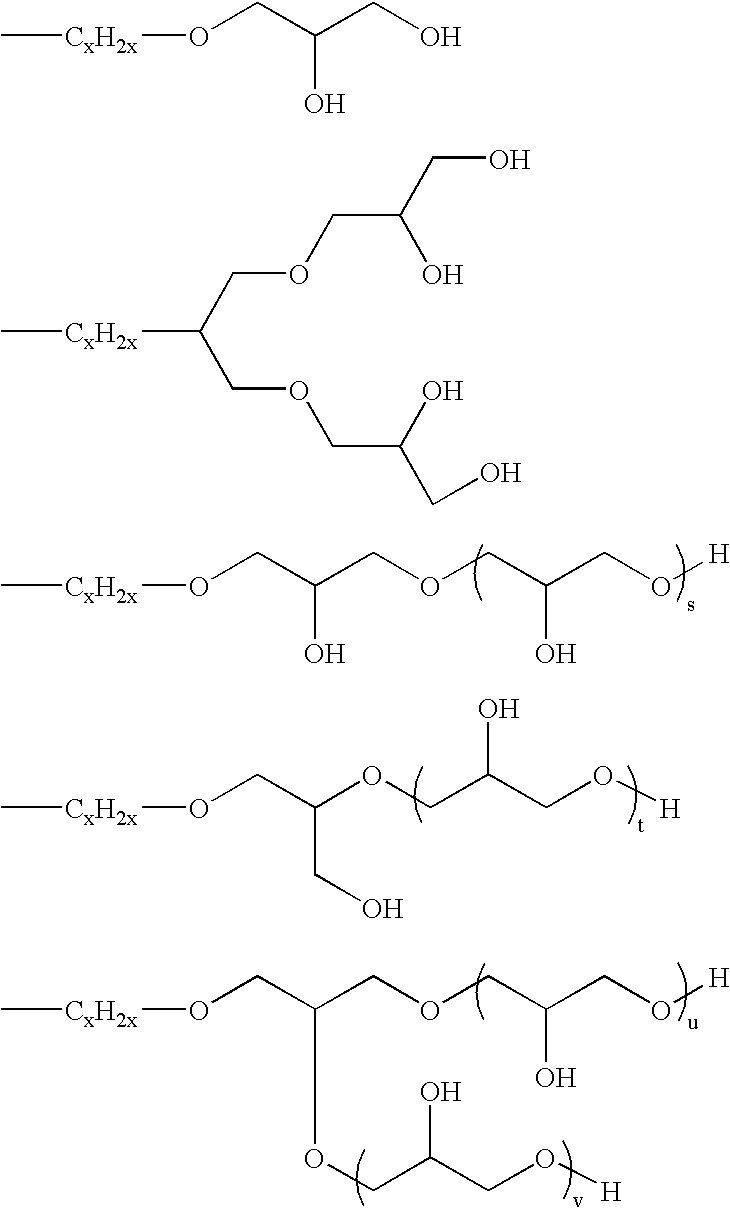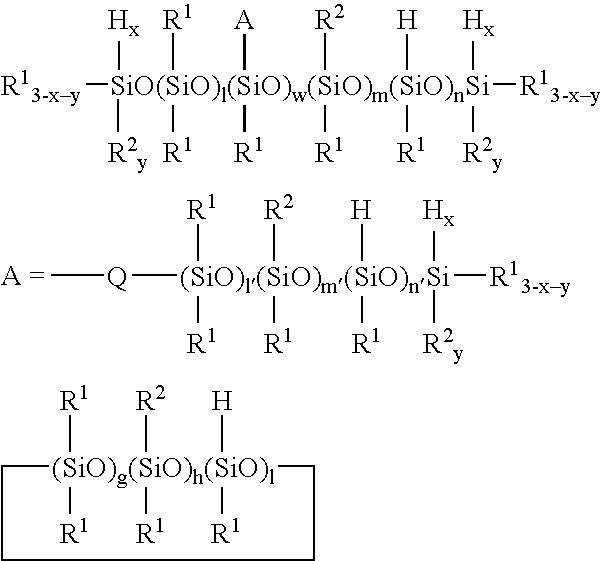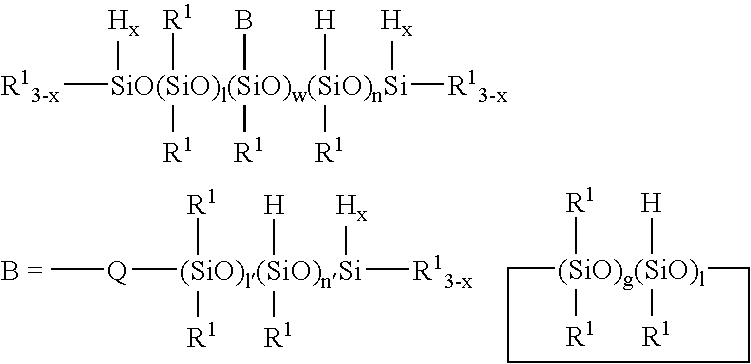Novel organopolysiloxane polymer, pasty composition, and cosmetic preparation containing the composition
a polymer and composition technology, applied in hair cosmetics, make-up, disinfection, etc., can solve the problems of uneven composition, high viscosity, and difficulty in obtaining uniform composition, and achieve the effect of low viscosity
- Summary
- Abstract
- Description
- Claims
- Application Information
AI Technical Summary
Benefits of technology
Problems solved by technology
Method used
Image
Examples
example 1
[0121] 200.0 of the organohydrogen polysiloxane expressed by the average formula M2D40DH2 as ingredient a2, 23.0 g of polyglycerol diarylether (G2) as ingredient b1, 148.7 g of dimethylpolysiloxane having a viscosity of 6 mm2 / s at 25° C., 74.3 g of isopropyl alcohol and 0.1 g of a 3 wt % ethanol solution of chlorplatinic acid, were introduced into a reaction vessel, and the mixture was stirred for 2 hours while the temperature was maintained at temperature at 70-80° C. to obtain an organopolysiloxane polymer.
[0122] Next, 43.5 g of a 1% citric acid aqueous solution was mixed in while maintaining the temperature at 70-80° C., and heating was continued for 3 hours. The reaction mixture was then cooled until the temperature fell to 50° C. or less, 7.0 g of 5% sodium hydrogen carbonate aqueous solution was added, and the reaction mixture was stirred for 1 hour while maintaining the temperature at 40-50° C. After stirring was complete, 0.11 g of d-6-tocopherol was added as antioxidant, t...
example 2
[0124] 200.0 g of the organohydrogen polysiloxane containing a lauryl group expressed by the average empirical formula M2D40Dc1210DH3 as ingredient a2, 18.3 g of polyglycerol diarylether (G2) as ingredient b1, 24.3 g of liquid paraffin, 48.5 g of isopropyl alcohol and 0.1 g of a 3 wt % ethanol solution of chlorplatinic acid, were introduced into a reaction vessel, and the mixture was stirred for 2 hours while the temperature was maintained at 70-80° C. to obtain an organopolysiloxane polymer.
[0125] Next, 43.7 g of a 1% citric acid aqueous solution and 121.2 g of liquid paraffin were mixed in while maintaining the temperature at 70-80° C., and the mixture was heated for 3 hours. The reaction mixture was then cooled until the temperature fell to 50° C. or less, 7.0 g of 5% sodium hydrogen carbonate aqueous solution was added, and the reaction mixture was stirred for 1 hour while maintaining the temperature at 40-50° C. After stirring was complete, 0.11 g of d-6-tocopherol was added a...
example 3
[0127] 200.0 g of the organohydrogen polysiloxane containing a lauryl group expressed by the average empirical formula M2D40Dc1210DH3 as ingredient a2, 18.3 g of polyglycerol diarylether (G2) as ingredient b1, 327.5 g of glycerol triooctanoate, 109 g of isopropyl alcohol and 0.1 g of a 3 wt % ethanol solution of chlorplatinic acid, were introduced into a reaction vessel, and the mixture was stirred for 2 hours while the temperature was maintained at 70-80° C. to obtain an organopolysiloxane polymer.
[0128] Next, 43.7 g of a 1% citric acid aqueous solution was mixed in while maintaining the temperature at 70-80° C., and heating was continued for 3 hours. The reaction mixture was then cooled until the temperature fell to 50° C. or less, 7.0 g of 5% sodium hydrogen carbonate aqueous solution was added, and the reaction mixture was stirred for 1 hour while maintaining the temperature at 40-50° C. After stirring was complete, 0.11 g of d-6-tocopherol was added as antioxidant, the tempera...
PUM
| Property | Measurement | Unit |
|---|---|---|
| kinematic viscosity | aaaaa | aaaaa |
| wt % | aaaaa | aaaaa |
| wt % | aaaaa | aaaaa |
Abstract
Description
Claims
Application Information
 Login to View More
Login to View More - R&D
- Intellectual Property
- Life Sciences
- Materials
- Tech Scout
- Unparalleled Data Quality
- Higher Quality Content
- 60% Fewer Hallucinations
Browse by: Latest US Patents, China's latest patents, Technical Efficacy Thesaurus, Application Domain, Technology Topic, Popular Technical Reports.
© 2025 PatSnap. All rights reserved.Legal|Privacy policy|Modern Slavery Act Transparency Statement|Sitemap|About US| Contact US: help@patsnap.com



